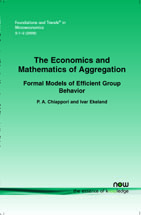The Economics and Mathematics of Aggregation: Formal Models of Efficient Group Behavior
By P. A. Chiappori, Columbia University, USA, pc2167@columbia.edu | Ivar Ekeland, University of British Columbia, Canada, ekeland@math.ubc.ca
Abstract
The goal of this article is to provide a general characterization of group behavior in a market environment. A crucial feature of our approach is that we do not restrict the form of individual preferences or the nature of individual consumptions; we allow for public as well as private consumption, for intragroup production, and for any type of consumption externalities across group members. Our only assumption is that the group always reaches Pareto efficient decisions.
We analyze two main issues. One is testability: what restrictions (if any) on the aggregate demand function characterize the efficient behavior of the group? The second question relates to identifiability; we investigate the conditions under which it is possible to recover the underlying structure — namely, individual preferences, the decision process and the resulting intragroup transfers — from the group's aggregate behavior.
Our approach applies to large (markets) or small (households) groups, with both private and public consumptions, with and without restrictions on trade, with monetary or real endowments. In particular, our approach generalizes the classical analysis of the aggregate demand of a market economy, as pioneered by Gerard Debreu, Ralph Manted and Hugo Sonnenchein; we devote a section of our work to this specific but important case.
We show that in all these contexts, aggregation of individual behaviors involves a common mathematical structure, whereby the aggregate demand of the group, considered as a vector field, can be decomposed into a sum of gradients. The proper way to understand this structure, and ultimately to find necessary and sufficient condition for such a decomposition to be possible, is to use tools which were developed about 100 years ago, mainly by the French mathematician Elie Cartan, and which are known now-a-days as exterior differential calculus (EDC). The last section of this article is devoted to an exposition of EDC and contains the proofs of the results in the preceding ones.
The Economics and Mathematics of Aggregation
The Economics and Mathematics of Aggregation provides a general characterization of group behavior in a market environment. A crucial feature of the authors' approach is that they do not restrict the form of individual preferences or the nature of individual consumptions. The authors allow for public as well as private consumption, for intragroup production, and for any type of consumption externalities across group members. The main questions addressed are: what restrictions (if any) on the aggregate demand function characterize the efficient behavior of the group and when is it possible to recover the underlying structure - namely, individual preferences, the decision process and the resulting intragroup transfers - from the group's aggregate behavior? The Economics and Mathematics of Aggregation takes an alternative, axiomatic perspective – the 'collective' approach – and assumes that the group always reaches Pareto efficient decisions. The authors view efficiency as a natural assumption in many contexts and as a natural benchmark in all cases. Finally, even in the presence of asymmetric information, first best efficiency is a natural benchmark. However, it is important to note that no restriction is placed on the form of the decision process beyond efficiency.
